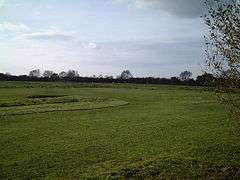Locking Castle
| Locking Castle | |
|---|---|
| Locking, Somerset, England | |
|
The site which is now a golf course | |
 Locking Castle | |
| Coordinates | 51°20′36″N 2°54′53″W / 51.3434°N 2.9147°W |
| Type | Motte and bailey |
Locking Castle was a castle that once stood on Carberry Hill near the site of RAF Locking in Locking in the North Somerset district of Somerset, England. It has been scheduled as an ancient monument.[1][2]
It was a motte and bailey on Carberry Hill. Excavations in 1902 identified the remains of a small stone chamber surrounded by a ditch.[3] Fragments of pottery and the remains of a sword were also found.[4] A coin from the period of Edward IV was also uncovered.[2]
Around the site of the castle is a 60 metres (200 ft) long bank which is around 1.5 metres (4 ft 11 in) high and a ditch.[5] An area west of the inner bailey has been identified as a possible pillow mound.[6]
The origin of the castle is unclear. It may have been part of the manor of Kewstoke or alternatively Hutton. The two manors were combined and given by Henry I to Geoffrey de Dun. In 1214 Locking was given to Woodspring Priory and would have ceased to have military significance.[7]
See also
References
- ↑ "Locking Castle". English Heritage. Retrieved 23 July 2011.
- 1 2 "Motte and bailey castle and associated earthworks south of Locking Head Farm". National heritage List for England. Historic England. Retrieved 30 September 2016.
- ↑ "Locking Castle". Archaeology Data Service. Retrieved 30 September 2016.
- ↑ "Locking Castle". Pastscape National Monument Record. English Heritage. Retrieved 22 July 2011.
- ↑ "Locking Castle, Carberry Hill". Castlefacts. Retrieved 30 September 2016.
- ↑ "Locking Castle, Carberry Hill". Gatehouse. Retrieved 30 September 2016.
- ↑ Dunning, Robert (1995). Somerset Castles. Tiverton: Somerset Books. pp. 39–40. ISBN 978-0-86183-278-1.
